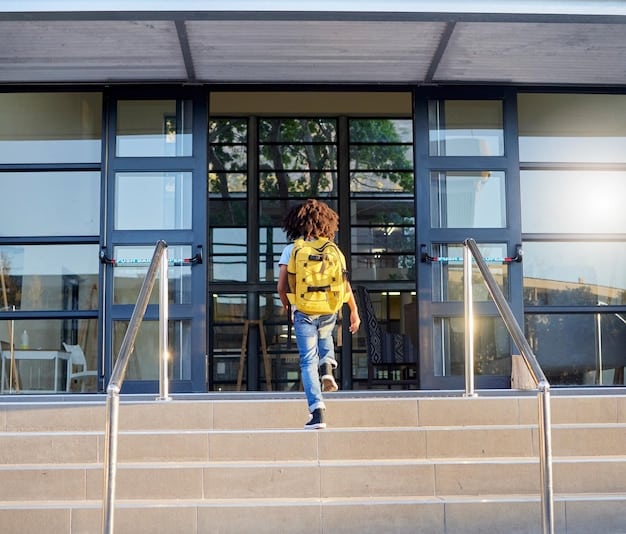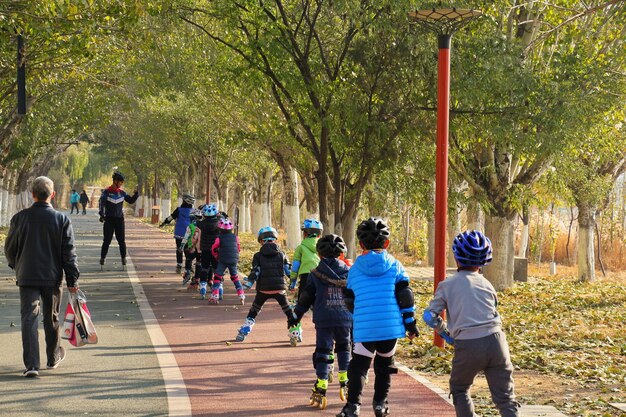School Zone Air Quality: Protecting Students’ Health

School Zone Air Quality: How Schools are Working to Reduce Pollution and Protect Student Health involves implementing strategies to minimize vehicle emissions, promote green transportation, and establish buffer zones, ensuring a healthier environment for students.
Ensuring the health and well-being of students is a top priority, and one critical aspect of this is addressing school zone air quality: How Schools are Working to Reduce Pollution and Protect Student Health. The air around schools can be heavily polluted due to traffic and other environmental factors, impacting children’s respiratory health and overall development.
Understanding the Impact of Air Pollution on Children’s Health
Children are particularly vulnerable to the detrimental effects of air pollution. Their respiratory systems are still developing, and they breathe more air per kilogram of body weight compared to adults. This increased exposure can lead to a range of health issues.
Respiratory Issues and Air Pollution
Air pollution can trigger and exacerbate respiratory problems in children. Conditions like asthma, bronchitis, and other respiratory infections are more common in areas with poor air quality.
Long-Term Health Risks
Prolonged exposure to air pollution can have long-term consequences for children’s health, including reduced lung function, increased risk of cardiovascular diseases, and even impaired cognitive development. It is essential to mitigate these risks by improving air quality in school zones.
- Increased risk of respiratory infections
- Exacerbation of asthma symptoms
- Reduced lung function
- Potential for long-term cardiovascular issues

Addressing air pollution in school zones not only protects children from immediate health issues but also lays the foundation for healthier lives in the future.
Identifying Sources of Pollution in School Zones
Pinpointing the main sources of air pollution in school zones is the first step toward developing effective mitigation strategies. Often, the primary culprits are related to transportation and nearby industrial activities.
Vehicle Emissions
Cars, buses, and trucks contribute significantly to air pollution around schools. The idling of vehicles during drop-off and pick-up times releases harmful pollutants into the air.
Industrial Activities
Schools located near industrial areas may be exposed to additional pollutants released from factories and other industrial facilities. These pollutants can include chemicals and particulate matter that further degrade air quality.
Construction and Roadwork
Construction sites and roadwork near schools can generate dust and other particulate matter, contributing to temporary but significant increases in air pollution levels.
- Cars and buses near schools release pollutants
- Industrial facilities
- Construction sites
By identifying these sources, schools and local authorities can implement targeted measures to reduce pollution and protect student health.
Implementing Green Transportation Initiatives
Encouraging alternative modes of transportation is a powerful way to reduce vehicle emissions around schools. Green transportation initiatives can promote healthier habits and improve air quality simultaneously.
Walking and Biking Programs
Walking and biking to school can significantly reduce the number of vehicles on the road during peak hours. Schools can organize walking school buses and bike trains to ensure children arrive safely.
Carpooling and Ride-Sharing
Carpooling and ride-sharing programs can decrease the number of individual vehicles transporting students. These initiatives can be incentivized through designated drop-off zones and other conveniences.

Green transportation initiatives not only reduce air pollution but also promote physical activity and create a sense of community.
Creating Buffer Zones and Green Spaces
Establishing physical barriers between schools and sources of pollution can significantly improve air quality. Buffer zones and green spaces act as natural filters, reducing the concentration of pollutants in the air.
Planting Trees and Vegetation
Trees and vegetation can absorb pollutants and provide shade, creating a healthier environment for students. Strategic planting can help to filter out harmful particles and improve overall air quality.
Designating No-Idling Zones
Implementing no-idling zones around schools can reduce the amount of pollutants released by idling vehicles. Signs and enforcement can help to ensure compliance with these zones.
- Planting trees absorbs pollutants
- No-Idling Zones
These measures can enhance the overall environment around schools, making it safer and healthier for children.
Utilizing Air Filtration Systems in Schools
Indoor air quality is also important for student health. Schools can utilize air filtration systems to remove pollutants from the air inside classrooms and other facilities. This proactive approach can create a healthier learning environment.
HEPA Filters
High-Efficiency Particulate Air (HEPA) filters can capture small particles, including allergens, dust, and pollutants. Installing HEPA filters in HVAC systems can improve indoor air quality significantly.
Activated Carbon Filters
Activated carbon filters can remove gases and odors from the air, providing an additional layer of protection against pollutants. These filters are particularly effective at removing volatile organic compounds (VOCs) and other harmful gases.
Air filtration systems help to maintain a healthy indoor environment, reducing the risk of respiratory issues and other health problems among students.
Raising Awareness and Education
Education and awareness campaigns are essential for promoting behavior changes and ensuring the long-term success of air quality initiatives. Involving students, parents, and the community can create a culture of environmental responsibility.
Educational Programs for Students
Schools can integrate air quality topics into the curriculum, teaching students about the sources and impacts of pollution. Engaging students in hands-on activities can enhance their understanding and encourage them to take action.
Community Outreach and Engagement
Organizing community events and workshops can raise awareness about air quality issues and promote participation in mitigation strategies. These initiatives can empower community members to make informed decisions and support efforts to improve air quality.
- Education is important
- Community workshops
By fostering a sense of collective responsibility, schools can create a lasting impact on air quality and student health.
| Key Point | Brief Description |
|---|---|
| 🚗 Vehicle Emissions | Reduce idling and promote green transport. |
| 🌳 Buffer Zones | Plant trees to filter pollutants around schools. |
| 🌬️ Air Filtration | Install HEPA filters for cleaner indoor air. |
| 📢 Awareness | Educate students and the community. |
Frequently Asked Questions
▼
Air quality in school zones is crucial because children are more vulnerable to air pollution, which can lead to respiratory issues and long-term health problems. Protecting their health ensures a better learning environment.
▼
The primary sources include vehicle emissions from cars and buses, nearby industrial activities, and construction sites. These release harmful pollutants that affect air quality around schools.
▼
Schools can promote walking and biking programs, encourage carpooling and ride-sharing, and provide incentives for using public transportation to reduce vehicle emissions.
▼
Air filtration systems, such as HEPA and activated carbon filters, remove pollutants from indoor air, creating a healthier learning environment and reducing the risk of respiratory issues.
▼
Community involvement is crucial for raising awareness and changing behaviors. When students, parents, and community members work together, they can create a culture of environmental responsibility.
Conclusion
Improving school zone air quality: How Schools are Working to Reduce Pollution and Protect Student Health requires a multifaceted approach that includes reducing vehicle emissions, creating buffer zones, utilizing air filtration systems, and raising awareness. By implementing these strategies, schools can create a safer and healthier environment, ensuring the well-being and academic success of their students.





